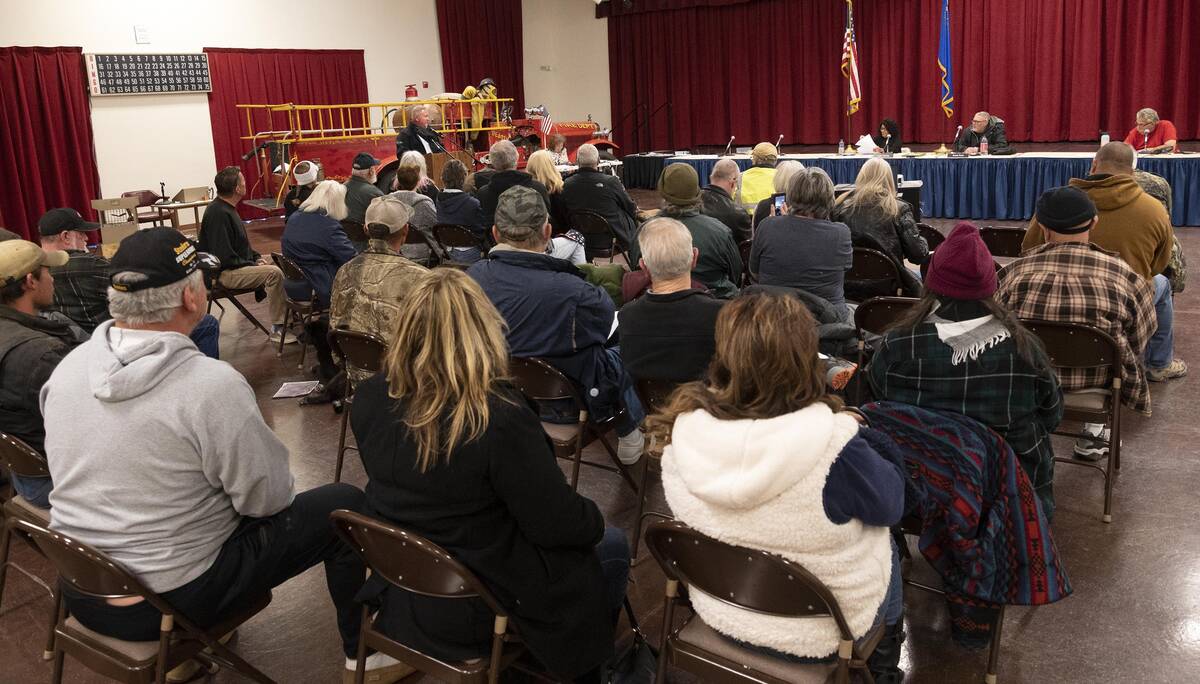
BEATTY — People here on the whole, continue to oppose the development of solar-energy projects in areas near the town. A sizable crowd showed up for the Beatty Town Advisory Board’s Utility Scale Solar Projects Workshop on Monday, Feb. 27 where Nye County Director of Planning Brett Waggoner told them that he was there to get their input.
“It’s your meeting,” he said. “I just want it to be productive.”
John Lupac said that locals’ feelings boiled down to “don’t fence me in.”
A common argument against large-scale projects around Beatty is that they would constrain future development in a community that’s already boxed in by its neigbors. The town is squeezed between a national park on one side and the Nevada Test and Training Range on the other.
Several people said that solar panels need to be handled as hazardous waste at the end of their life cycles, and Waggoner commented that the county’s landfills cannot handle them.
A couple of people said that large numbers of solar panels would raise the temperature as much as ten degrees and that the desert was already plenty hot.
Another argument was that the solar projects would result in the breaking of the desert’s crust, causing a dust hazard that would persist for decades.
John Lisle said that a better alternative would be to put solar panels on top of houses in California. He said this also would have the advantage of using existing power lines and not require the construction of new ones.
Beatty Water and Sanitation District General Manager Chad Marchand proposed that an exclusion zone should be created to protect the well head of the EW4 well, which is Beatty’s major source of water.
“It seems ridiculous that they are going to save our land by destroying it,” said Pahrump resident Jeannie Cox-King. “We will stand with Beatty.”
Laura Cunningham, like many Beatty residents, enjoys the beauty of the desert landscape and access to outdoor recreation, such as hiking and horse riding. These things are also a tourist attraction that is important to Beatty’s economy.
“You see kids doing their Instagram photos on the road to Death Valley, the desert highway,” she noted. “They don’t want to see solar panels.”
The general sentiment was that there are better places to put large-scale solar projects, with several people saying they should utilize land that is already disturbed or destroyed.
Debbie Baker advised suggesting alternatives instead of just saying “no, no, no.”
Beatty Town Advisory Board Chair Erika Gerling reacted emotionally upon hearing from Waggoner that a solar project on the edge of Clark County was using water purchased from a land owner in Pahrump.
“If you don’t want people to come here and do something,” said Gerling, “don’t make it attractive for them. Don’t give them tax breaks. Don’t sell them water.”
“Do we stand a chance of getting some kind of exclusion zone for our area?” queried resident Dee Crawford.
“I believe you have a very good chance,” responded Waggoner.
Following the workshop, the BTAB went into its regular meeting, quickly approving the sending of three letters.
The first was to the BLM Pahrump Field Office, requesting that Beatty stakeholders be involved in pre- and post-race course inspections for off-road events. An identical letter was previously sent to the Tonopah Field Office.
The second was to Death Valley National Park encouraging efforts to reopen Titus Canyon and offering help.
The last was a slightly revised draft of the previously approved letter to the BLM regarding their Notice of Intent to prepare a programmatic Environmental Impact Statement to evaluate for utility-scale energy planning and amend Resource Management plans for renewable energy development.
Richard Stephens is a freelance reporter living in Beatty.